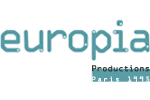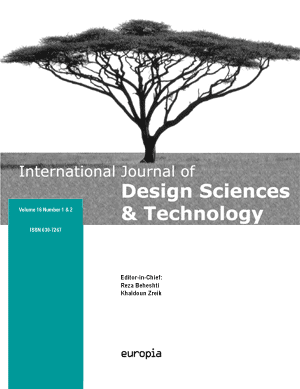International Journal
of
DESIGN
Sciences
&Technology
Editors:
Edwin DADO & Khaldoun ZREIK
(Journal empowered by the CNU 71e and the HCERES in SIC since 2016)
(Revue habilitée par le CNU 71e et l'HCERES en SIC depuis 2016)
IJDST
ISSN
1630-7267
- Introduction
- Editorial Board
- Editors
- Submission
- Topics
- Subscription
- Volumes Acquisition
- Issue Acquisition
- Contact
Submission
The International Journal of Design Sciences and Technology is an independent and open platform for disseminating design knowledge. The design of new products drives to solve problems that their solutions are still partial and their tools and methods are rudimentary. Design is applied in extremely various fields and implies numerous agents during the entire process of elaboration and realisation. The International Journal of Design Sciences and Technology is a multidisciplinary forum dealing with all facets and fields of design. It endeavours to provide a framework with which to support debates on different social, economic, political, historical, pedagogical, philosophical, scientific and technological issues surrounding design and their implications for both professional and educational design environments. The focus is on both general as well as specific design issues, at the level of design ideas, experiments and applications.
There is no deadline for the publication of an accepted paper that will be published online within one to four months after the final re-submission is accepted. The hardcopy book of the volume will be published when 8 papers are published online. The corresponding author of a paper published in the International Journal of Design Sciences and Technology will receive a digital copy of the author’s paper free of charge. Hard copies of any individual paper (minimum 100 copies) and the hardcopy of the IJDST Volume (containing 8 papers published online) can be purchased from the publisher (ask for an invoice from the publisher IJDST@europia.org). Also proposals can be submitted to the Editor-in-Chief for special issues covering one of the subject areas of the journal or a relevant topic.
Instructions for Authors and Review Process
Pre-review Stage (Editor Global Review): Papers can only be considered for review when they deal with a subject relevant to the content of the journal. In addition all papers submitted must follow the journal’s paper structure and Author Instructions before they can be considered for review. These instructions also affect the content of the paper. Authors can choose to submit a short paper (about 5000-8000 words). The preferred size of a paper (monograph) is about 10000 words (maximum 15000 words). The title must not be longer than seven words. Subtitles are not permitted. The maximum length of the abstract is 150 words. All papers must contain an introductory chapter with extensive literature review of similar research. The paper devotes at least one chapter to detailed discussion of research questions, research analysis and research methods. The conclusion will summarise the research and its results. In addition this chapter includes a detailed discussion of applications, advantage, shortcomings and implications of the investigation as well as future research for both design professionals and the design education. Submit a paper at this stage as PDF.
Review Stage (Peer Review): Only papers meeting all IJDST requirements can be considered for review. All papers are blind-reviewed by at least two expert reviewers. The main author of a reviewed and accepted paper will be notified with instructions to resubmit the paper. All reviewed and accepted papers have to be resubmitted, implementing reviewers and editors comments and/or suggestions. Only accepted papers conforming to instructions will be considered for publication in the International Journal of Design Sciences and Technology. A paper should follow the IJDST paper structure. The review process will be repeated until all requirements are met.
The first page of the paper must contain the full title of the paper as well as the Name (no initials) & Surname, affiliation, address, telephone, fax and email of the corresponding author to whom all correspondence to be directed. If applicable please also mention the Name (no initials) & Surname, affiliation, postal address, telephone, fax and email of the co-author(s).The second page contains the full title of the paper (maximum 7 words), the sub-title is not permitted, an abstract of about 50 to 150 words summarising the content of the paper and 3-5 keywords for the purpose of indexing (the use of references in the abstract is discouraged). The length of a short paper is about 5000-800 words. The preferred size of a paper (monograph) is about 10000 words (maximum 15000 words). The use of Footnotes is permitted (maximum length is about 50 words). Footnotes should be numbered consecutively. For instance: [[17 A ‘footnote’ reflects additional information, a reference or the URL of a website]].
The paper will be written in the UK English. It will be single-spaced with 30 mm margins on all sides (paper size A4). Use Times New Roman for the main body of text (size 10), figures (size 8) or tables (size 8). The use of Bold, Italics, ALL CAPS, SMALL CAPS, etc. is discouraged. All chapters should be numbered consecutively (more than two level sub-headings is discouraged). All Figures and Tables with their respective captions should be numbered consecutively. They should each, be placed on a separate page, at the end of the paper. Give an approximate insertion point for figures and tables, between double square brackets. For instance: [[insert Figure 5]]. You will be asked to resubmit tables, figures and images if necessary. The paper must be submitted in plain text. Do not layout your paper. Do not use any styles or any automatic layout system. Please do not use ‘Track Changes’.
All tables should be clearly referred to in the main body of text as Table 1, Table 2, etc. All Figures should be clearly referred to in the main body of text as Figure 1, Figure 2, etc. Line drawings should be of good quality. Use light background if possible (white is preferred). Photographs and screen-shots should also be submitted separately as JPEG files (use high resolution for better results). Authors should prepare high quality figures and drawings. The use of colours in your illustrations is permitted although the hardcopy of the journal is not published in colour. Maximum width and height of a figure are respectively 150 mm and 190 mm. Maximum width and height of a table are respectively 115 mm and 170 mm. All Equations will be numbered consecutively and should be clearly mentioned in the main body of text.
All references will appear at appropriate places in the main body of text. References are collected at the end of the paper and are arranged in alphabetical order (numbered consecutively) by the first author's surname, followed by initials. All authors should be mentioned. Dates will appear between brackets after the authors' name(s). This is followed by the title of the book, name of the publisher, place of publication and page numbers (if applicable). To refer to a journal paper, add the full title of the journal followed by Volume:Number and page(s).
The number of references to the author’s own previous publications will not exceed 5% of the total number of references. References that are not mentioned in the main body of text are not allowed. Examples of references to a book, a journal or a website are shown below:
[1] Beckett K L and Shaffer D W (2004) Augmented by Reality: The Pedagogical Praxis of Urban Planning as a Pathway to Ecological Thinking, University of Wisconsin, Madison
[2] Blackman, D A (2001) Does a Learning Organisation Facilitate Knowledge Acquisition and Transfer? Electronic Journal of Radical Organization Theory, 7:2 [www.mngt.waikato.ac.nz/Research/ ejrot/Vol7_1/Vol7_1articles/blackman.asp]
[3] Buxton, W (1997) Living in Augmented Reality: Ubiquitous Media and Reflective Environments. In: Finne K, Sellen A and Wilber S eds, Video Mediated Communication, Erlbaum, Hillsdale N.J., 363-384
[4] Dixon, N M (2000) Common Knowledge: How companies thrive by sharing what they know, Harvard Business School Press, Boston, MA
[5] Djenidi H, Ramdane-Cherif A, Tadj C and Levy N (2004). Generic Pipelined Multi-Agents Architecture for Multimedia Multimodal Software Environment, Journal of Object Technology, 3:8, 147-169
[6] Gorard, S and Selwynn, N (1999) Switching on to the learning society? Questioning the role of technology in widening participation in lifelong learning, Journal of Education Policy, 14:5, 523-534
[7] World Bank (2002) Social assessment as a method for social analysis, World Bank Group [www.worldbank.org/gender/resources/assessment/samethod.htm]The definitive paper is submitted as plain text MS Word file for the PC (MS Word RTF format for the Macintosh). In addition, a formatted version of the paper (including images and tables at their approximate places) will be submitted in PDF format (to be used as a guideline for the layout). All figures must be submitted separately in high resolution jpg format. Submit your paper as an email attachment addressed to the Editor-in-Chief [ijdst@europia.org].
Author(s) of an accepted paper have to complete, sign and return a Copyrights Transfer Form to the publisher. This copyrights transfer assignment will ensure the widest possible dissemination of information. Papers published in the International Journal of Design Sciences and Technology cannot be published elsewhere, in any form (digital, paper-based or otherwise) without a prior written permission from the publisher.
The author(s) are responsible for obtaining permission to utilize any copyrighted material. For more details about this subject, please contact the publisher at an early stage.
A paper can be rejected at any stage if the requirements are not met. The decision of the Editor-in-Chief on all matters related to the International Journal of Design Sciences and Technology including the review process, publication of papers, etc. is final and cannot be disputed.
There is no deadline for the publication of an accepted paper that will be published online within one to four months after the final re-submission is accepted. The hardcopy book of the volume will be published when 8 papers are published online. The corresponding author of a paper published in the International Journal of Design Sciences and Technology will receive a digital copy of the author’s paper free of charge. Hard copies of any individual paper (minimum 100 copies) and the hardcopy of the IJDST Volume (containing 8 papers published online) can be purchased from the publisher (ask for an invoice from the publisher IJDST@europia.org).
Proposals can be submitted to the Editor-in-Chief for special issues covering one of the subject areas of the journal or a relevant topic.
Volumes

